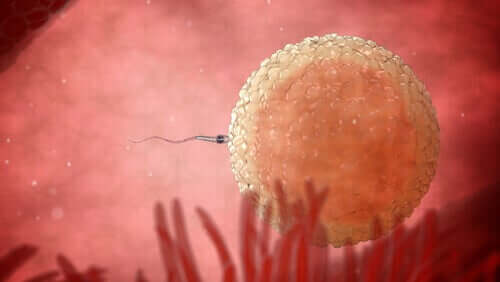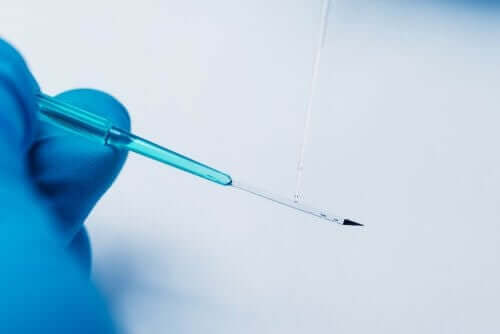What Is a Preimplantation Genetic Diagnosis?

Preimplantation genetic diagnosis (PGD) is a recently developed diagnostic technique that’s performed on the embryos before they’re implanted in the uterus. Through this test, you can determine the genetic status of each of the embryos and choose to transfer only the healthy ones to the uterus.
There are three types of PGD tests: a directed PGD, which is responsible for determining which embryos are free of any single gene genetic disease; there’s a PGD test that analyzes the existence of genetic disorders that affect one or more chromosomes; and a PGD test to detect aneuploidies.
What happens during a preimplantation genetic diagnosis?
According to the Journal of Medical Genetics, the first PGD performed took place in the nineties, but it could only detect diseases linked to the X chromosome. However, technological advances, such as DNA amplification and improvements in embryo culture techniques, allow making more accurate diagnoses.
But, what does a PGD test imply?
- In vitro fertilization to obtain embryos.
- Embryo biopsy: It’s performed in the first 72-76 hours after the recovery of the ovules when the embryo is in a 6-8 cells state. To do this, a cell is removed from the embryo, without compromising its healthy development. After a biopsy, the technicians return the embryo to the laboratory incubator to keep it in an in vitro culture with the appropriate environmental conditions.
- Genetic analysis: Preparing the cells obtained during the biopsy for analysis and genetic study.
Embryo transfer: After receiving the genetic analysis, the assisted reproduction team gets the data and, after analyzing the reports, determines which embryos to transfer according to their chromosomal endowment, their morphological characteristics and embryonic viability.
“While the medical technician performs the biopsy, extraction of one cell doesn’t affect the normal development of the rest of the cells.”

Advantages of having the preimplantation genetic diagnosis test
Taking a preimplantation genetic diagnosis test has several advantages. Among the most important is being able to avoid transmitting genetic diseases. Other benefits include the following:
- You avoid transferring embryos that won’t implant anyway: By obtaining this diagnosis, medical doctors can determine the existence of chromosomal alterations; these often prevent the embryo from developing correctly or implanting in the mother’s uterus.
- It decreases the time of conception during pregnancy: Through PGD, you can determine which embryos are healthy and will allow a pregnancy to occur; that way, you avoid transferring unhealthy embryos.
- Improved embryo selection: When the diagnosis is applied, chromosomally healthy embryos can be selected.
- Lower cost: It may seem like this diagnosis could be more expensive, but it avoids the need to freeze and maintain the embryos that seem healthy but may not be so, genetically.
- Reduces uncertainty: It guarantees that the embryo is healthy and also reduces the risk of a miscarriage.
What types of PGD are there?
You can take any of the three PGD tests at any gynecological, obstetrics and assisted reproduction centers. However, it’s only necessary in one of these cases:
A PGD to study aneuploidy
Generally, this type of analysis takes place in a sterile environment. In principle, technicians count the number of chromosomes in the embryos; and, subsequently, select the embryos with the correct amount of chromosomes. Generally, this happens when:
- The woman is over 38 years of age.
- The couple has had two or more miscarriages.
- They tried in vitro fertilization twice without success.
- There are chromosomal alterations in the spermatozoa.
- There are alterations during male meiosis.

A PGD to study hereditary diseases
This is done when one of the members of the couple is a carrier of a hereditary disease. Some of the most common ailments can be cystic fibrosis and muscular dystrophy, among others.
A PGD to study chromosomal anomalies
The is done when a member of the couple is a carrier of a chromosomal abnormality. In this analysis, we determine which embryos are healthy and have the correct number of chromosomes.
Before carrying out any test or analysis, it’s essential to inform yourself and consult directly with a specialist. A professional will be able to inform you and your partner adequately, giving you the best options.
Preimplantation genetic diagnosis (PGD) is a recently developed diagnostic technique that’s performed on the embryos before they’re implanted in the uterus. Through this test, you can determine the genetic status of each of the embryos and choose to transfer only the healthy ones to the uterus.
There are three types of PGD tests: a directed PGD, which is responsible for determining which embryos are free of any single gene genetic disease; there’s a PGD test that analyzes the existence of genetic disorders that affect one or more chromosomes; and a PGD test to detect aneuploidies.
What happens during a preimplantation genetic diagnosis?
According to the Journal of Medical Genetics, the first PGD performed took place in the nineties, but it could only detect diseases linked to the X chromosome. However, technological advances, such as DNA amplification and improvements in embryo culture techniques, allow making more accurate diagnoses.
But, what does a PGD test imply?
- In vitro fertilization to obtain embryos.
- Embryo biopsy: It’s performed in the first 72-76 hours after the recovery of the ovules when the embryo is in a 6-8 cells state. To do this, a cell is removed from the embryo, without compromising its healthy development. After a biopsy, the technicians return the embryo to the laboratory incubator to keep it in an in vitro culture with the appropriate environmental conditions.
- Genetic analysis: Preparing the cells obtained during the biopsy for analysis and genetic study.
Embryo transfer: After receiving the genetic analysis, the assisted reproduction team gets the data and, after analyzing the reports, determines which embryos to transfer according to their chromosomal endowment, their morphological characteristics and embryonic viability.
“While the medical technician performs the biopsy, extraction of one cell doesn’t affect the normal development of the rest of the cells.”

Advantages of having the preimplantation genetic diagnosis test
Taking a preimplantation genetic diagnosis test has several advantages. Among the most important is being able to avoid transmitting genetic diseases. Other benefits include the following:
- You avoid transferring embryos that won’t implant anyway: By obtaining this diagnosis, medical doctors can determine the existence of chromosomal alterations; these often prevent the embryo from developing correctly or implanting in the mother’s uterus.
- It decreases the time of conception during pregnancy: Through PGD, you can determine which embryos are healthy and will allow a pregnancy to occur; that way, you avoid transferring unhealthy embryos.
- Improved embryo selection: When the diagnosis is applied, chromosomally healthy embryos can be selected.
- Lower cost: It may seem like this diagnosis could be more expensive, but it avoids the need to freeze and maintain the embryos that seem healthy but may not be so, genetically.
- Reduces uncertainty: It guarantees that the embryo is healthy and also reduces the risk of a miscarriage.
What types of PGD are there?
You can take any of the three PGD tests at any gynecological, obstetrics and assisted reproduction centers. However, it’s only necessary in one of these cases:
A PGD to study aneuploidy
Generally, this type of analysis takes place in a sterile environment. In principle, technicians count the number of chromosomes in the embryos; and, subsequently, select the embryos with the correct amount of chromosomes. Generally, this happens when:
- The woman is over 38 years of age.
- The couple has had two or more miscarriages.
- They tried in vitro fertilization twice without success.
- There are chromosomal alterations in the spermatozoa.
- There are alterations during male meiosis.

A PGD to study hereditary diseases
This is done when one of the members of the couple is a carrier of a hereditary disease. Some of the most common ailments can be cystic fibrosis and muscular dystrophy, among others.
A PGD to study chromosomal anomalies
The is done when a member of the couple is a carrier of a chromosomal abnormality. In this analysis, we determine which embryos are healthy and have the correct number of chromosomes.
Before carrying out any test or analysis, it’s essential to inform yourself and consult directly with a specialist. A professional will be able to inform you and your partner adequately, giving you the best options.
All cited sources were thoroughly reviewed by our team to ensure their quality, reliability, currency, and validity. The bibliography of this article was considered reliable and of academic or scientific accuracy.
- Lledó, Belén. (2017). Ventajas e inconvenientes del Diagnóstico Genético Preimplantacional. Grupo Instituto Bernabeu.
- Sebastián, Irene. (2017). Diagnóstico Genético Preimplantacional: ¿Qué es? ¿Para qué sirve? El Blog de divulgación de Revista Genética Médica.
This text is provided for informational purposes only and does not replace consultation with a professional. If in doubt, consult your specialist.








